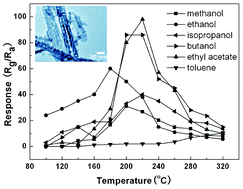In(OH)3 particles from an ionic liquid precursor and their conversion to porous In2O3 particles for enhanced gas sensing properties
Abstract
The

* Corresponding authors
a
Key Laboratory for Liquid–Solid Structural Evolution and Processing of Materials, School of Materials Science and Engineering, Shandong University, Jinan, Shandong Province, P. R. China
E-mail:
zhonghaoli@sdu.edu.cn
Tel: +86-531-88399670
b School of Pharmaceutical Sciences, Shandong University, Jinan, P. R. China
c Key Lab of Colloid and Interface Chemistry, Shandong University, Ministry Of Education, Jinan, P. R. China
The

 Please wait while we load your content...
Something went wrong. Try again?
Please wait while we load your content...
Something went wrong. Try again?
Z. Li, Y. Li, Y. Luan, J. Li and A. Song, CrystEngComm, 2013, 15, 1706 DOI: 10.1039/C2CE26733K
To request permission to reproduce material from this article, please go to the Copyright Clearance Center request page.
If you are an author contributing to an RSC publication, you do not need to request permission provided correct acknowledgement is given.
If you are the author of this article, you do not need to request permission to reproduce figures and diagrams provided correct acknowledgement is given. If you want to reproduce the whole article in a third-party publication (excluding your thesis/dissertation for which permission is not required) please go to the Copyright Clearance Center request page.
Read more about how to correctly acknowledge RSC content.
 Fetching data from CrossRef.
Fetching data from CrossRef.
This may take some time to load.
Loading related content
